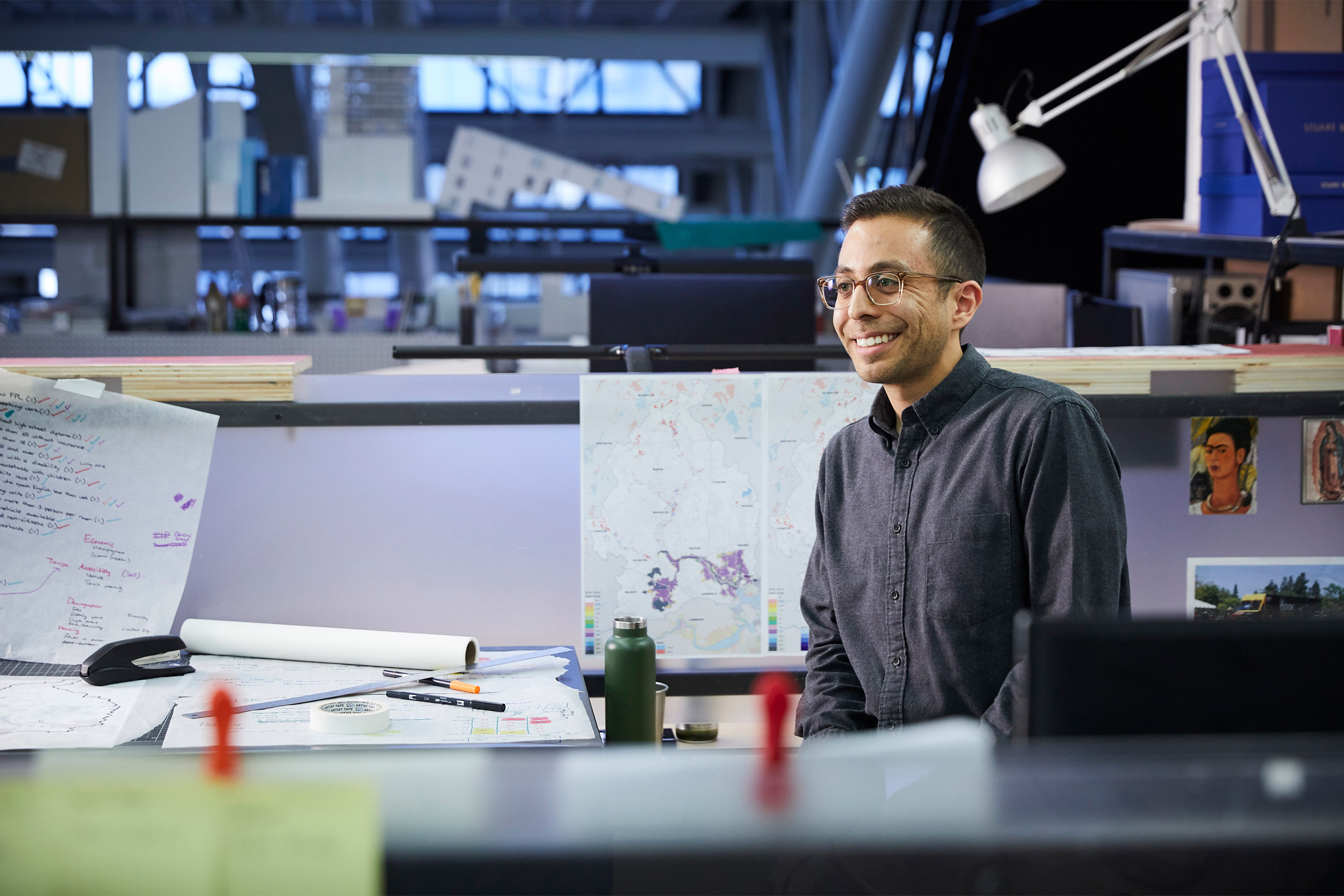
Juan Reynoso’s interest in the intersection of health and design traces back to his parents, who were born in rural Mexico and immigrated to California.
Photo by Kent Dayton
Breaking ground with new degree
Juan Reynoso bridging the worlds of public health and urban planning
This is one in a series of profiles showcasing some of Harvard’s stellar graduates.
Juan Reynoso is about to step into largely uncharted territory. When he graduates this spring, he’ll be only the second person to have completed a new joint Master in Public Health (M.P.H.)/Master in Urban Planning (M.U.P.) degree program. Launched in 2016 by Harvard T.H. Chan School of Public Health and Harvard Graduate School of Design (GSD), the program allows students to pursue a transdisciplinary education in urban planning and public health and sharpen their understanding of key areas including policy, sustainability, and social determinants of health.
Over the course of the program, Reynoso has bounced between studios at GSD, where he’s wrestled with urban planning challenges, and classrooms at Harvard Chan School, where he’s learned about population health and has grown especially interested in how environmental exposures, such as air pollution or tainted drinking water, affect health.
“It’s so interesting because each graduate School at Harvard has its own culture, its own pedagogy, its own way of thinking,” Reynoso says. “This program has allowed me to break out of those silos. And that’s helped me to better make connections among a wide variety of disciplines so I can analyze how certain urban planning efforts have health co-benefits or how certain health interventions have environmental benefits.”
Pollution in the valley
Reynoso’s interest in the intersection of health and design traces back to his parents. They were born in rural Mexico and immigrated to California, living first outside of Los Angeles and later moving to the Central Valley — the inland stretch of California that’s one of the most important agricultural hubs in the world. “I was born in Tulare County, which is a pretty rural agricultural area that consistently has some of the worst air quality and water quality in the country,” he said.
As a young boy, Reynoso was oblivious to the air pollution that drifted into the valley from nearby cities and the myriad pesticides that doused the surrounding farmland and would get kicked up into the atmosphere when strong winds swept through. Looking back now, he can’t help but wonder whether the environment of Tulare County was harming him. “I was very sickly as a child,” he recalled. “I missed half of my kindergarten year because I was always ill with respiratory diseases. How is a child supposed to be successful when the environmental exposures surrounding them are making them sick?”
Reynoso’s family eventually picked up and moved to Escondido, a city in San Diego County. The difference in his health was “night and day,” he said. “Rather than miss half the school year, I’d miss like 10 days at most.”
Reynoso was an excellent student and by high school his schedule was stacked with advanced placement classes. Around the same time, a series of wildfires tore through Southern California and came unsettlingly close to Escondido. Smoke and haze lingered in the air and Reynoso started wondering what that meant for his and his community’s health. “I was taking a class in environmental science at the time, and all these things started clicking for me,” he said.
With these experiences in mind, Reynoso chose to major in human biology with a concentration in environmental health at Stanford University. After graduating, he joined The California Endowment, a statewide foundation focused on health. While there, he worked on its Building Healthy Communities initiative, exploring a wide range of issues that sat at the intersection of policy, urban planning, and health, including active transportation and community land use.
Bridging disciplines
When Reynoso began exploring graduate schools, the joint M.P.H./M.U.P. program hit all the right notes. It blended his interests and fit his ambitions to improve community health through cross-disciplinary strategies.
“Juan is an energetic problem solver. As one of the first students in the joint M.P.H./M.U.P. program, he has been active in helping to build a community of students. As a leader in the Healthy Places Student Group at the GSD, an area of growing student interest, Juan has been really active in organizing events and promoting dialogue,” said Ann Forsyth, Ruth and Frank Stanton Professor of Urban Planning and director of the Master in Urban Planning Program at the GSD.
Joseph Allen, assistant professor of exposure assessment science at Harvard Chan School, said it’s heartening to see students like Juan push the field of public health forward. One of the shortcomings in Allen’s own public health training, he said, was a lack of focus on building science, design, and urban planning. “Juan is working to bridge the gap between these disciplines,” Allen said. “He really is a pioneer.”
Reynoso isn’t sure what his next step will be after he graduates. But he knows that he wants to tackle some of the biggest health and environmental challenges in a way that prioritizes equity and justice. He thinks back often to his childhood in the Central Valley, and of the disparities that persist across his beloved home state. He hopes that his training at Harvard can help remedy some of these problems.
“California is the richest state in the richest country in the world, and there are millions of people who don’t have access to clean drinking water or who are constantly exposed to air pollution or who are harmed by the environment in which they live in myriad other ways,” he said. “We need to work collectively in order to solve the public health challenges of today.”




